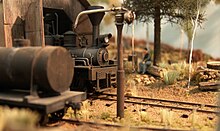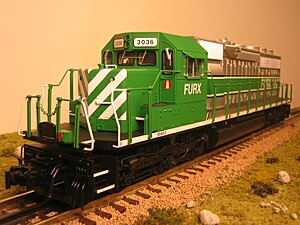O scale
| O scale | |
|---|---|

Australian O scale model railway
|
|
| Scale | 7 mm to 1 ft – 6.35 mm to 1 ft |
| Scale ratio | various: 1:48 to 1:43.5 |
| Model gauge | 30 mm (1.181 in) – 33 mm (1.3 in) |
| Prototype gauge | 1,435 mm (4 ft 8 1⁄2 in) standard gauge |
| British O gauge | |
|---|---|

British outline O gauge model railway at Kew Pumping Station
|
|
| Scale | 7 mm to 1ft |
| Scale ratio | 1:43.5 |
| Model gauge | 32 mm |
| Prototype gauge | Standard gauge |
| US O gauge | |
|---|---|

Typical US O-Scale locomotive
|
|
| Scale | 1/4 inch to 1ft |
| Scale ratio | 1:48 |
| Standard(s) | NMRA |
| Model gauge | 32 mm |
| Prototype gauge | Standard gauge |
O scale (or O gauge) is a scale commonly used for toy trains and model railroading. Originally introduced by German toy manufacturer Märklin around 1900, by the 1930s three-rail alternating current O gauge was the most common model railroad scale in the United States and remained so until the early 1960s. In Europe, its popularity declined before World War II due to the introduction of smaller scales.
O gauge had its heyday when model railroads were considered toys, with more emphasis placed on cost, durability, and the ability to be easily handled and operated by pre-adult hands. Detail and realism were secondary concerns, at best. It still remains a popular choice for those hobbyists who enjoy running trains more than they enjoy other aspects of modelling but developments in recent years have addressed the concerns of scale model railroaders making O scale popular among fine-scale modellers who value the detail that can be achieved.
The size of O and OO/HO layouts is also an important factor in making the decision to build an O gauge layout.
Collecting vintage O gauge trains is also popular and there is a market for both reproduction and vintage models.
The name for O gauge and O scale is derived from "0 [zero] gauge" or "Gauge 0" being smaller than Gauge 1 and the other then existing standards. It was created in part because manufacturers realized their best selling trains were those built in the smaller scales.
In the United States, manufacturers such as the Ives Manufacturing Company, American Flyer, and Lionel Corporation used O gauge for their budget line, marketing either Gauge 1 or Wide gauge (also known as standard gauge) as their premium trains. One of the Lionel Corporation's most popular trains, the 203 Armoured Locomotive, was O gauge and ran on tracks with rails spaced 1.25 inches apart. The Great Depression wiped out demand for the expensive larger trains, and by 1932, O gauge was the standard, almost by default.
...
Wikipedia
